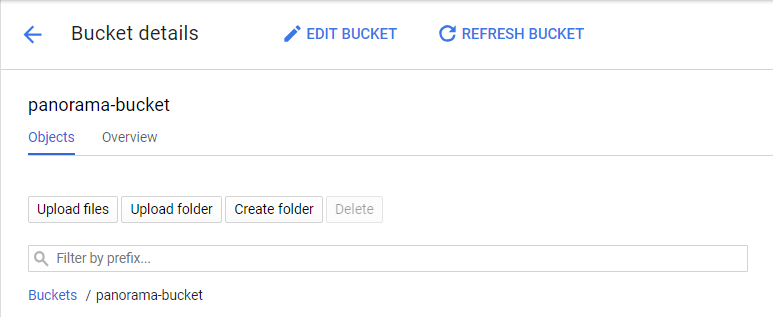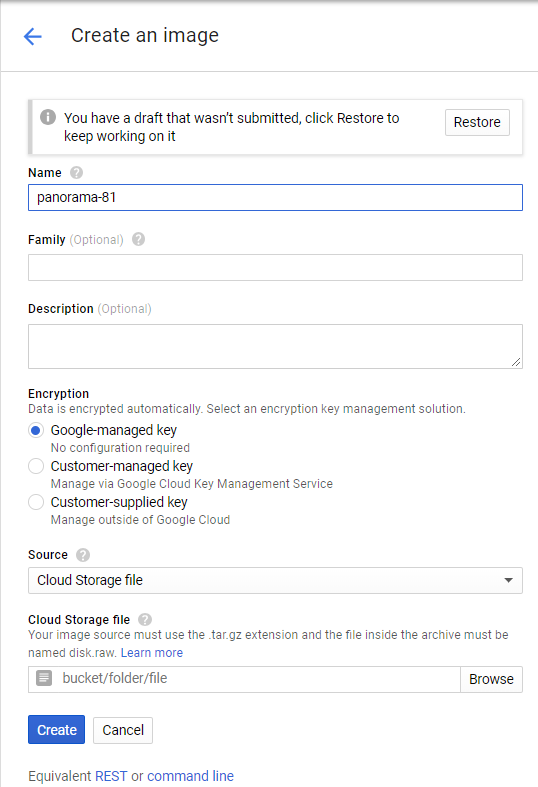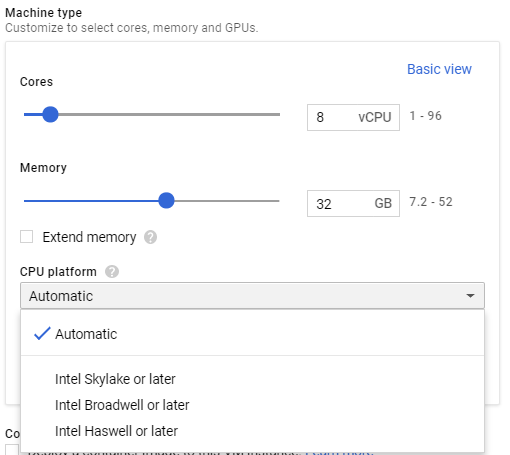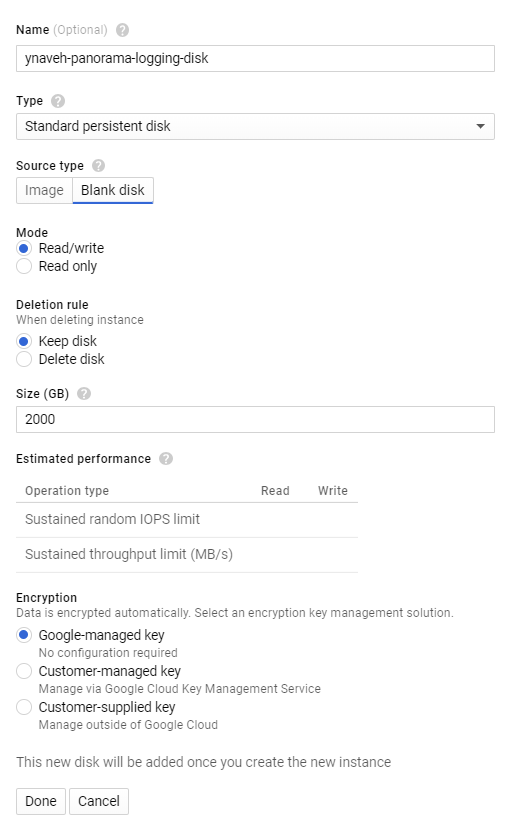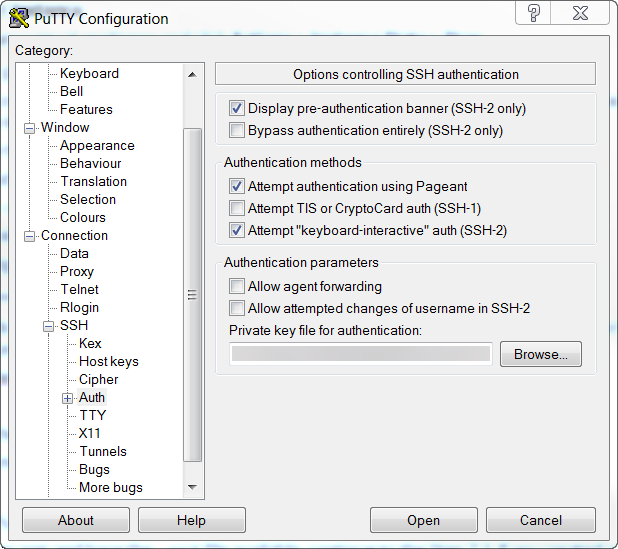Install Panorama on Google Cloud Platform
Table of Contents
10.0 (EoL)
Expand all | Collapse all
-
- Determine Panorama Log Storage Requirements
-
- Setup Prerequisites for the Panorama Virtual Appliance
- Perform Initial Configuration of the Panorama Virtual Appliance
- Set Up The Panorama Virtual Appliance as a Log Collector
- Set Up the Panorama Virtual Appliance with Local Log Collector
- Set up a Panorama Virtual Appliance in Panorama Mode
- Set up a Panorama Virtual Appliance in Management Only Mode
-
- Preserve Existing Logs When Adding Storage on Panorama Virtual Appliance in Legacy Mode
- Add a Virtual Disk to Panorama on an ESXi Server
- Add a Virtual Disk to Panorama on vCloud Air
- Add a Virtual Disk to Panorama on Alibaba Cloud
- Add a Virtual Disk to Panorama on AWS
- Add a Virtual Disk to Panorama on Azure
- Add a Virtual Disk to Panorama on Google Cloud Platform
- Add a Virtual Disk to Panorama on Hyper-V
- Add a Virtual Disk to Panorama on KVM
- Add a Virtual Disk to Panorama on Oracle Cloud Infrastructure (OCI)
- Mount the Panorama ESXi Server to an NFS Datastore
-
- Increase CPUs and Memory for Panorama on an ESXi Server
- Increase CPUs and Memory for Panorama on vCloud Air
- Increase CPUs and Memory for Panorama on Alibaba Cloud
- Increase CPUs and Memory for Panorama on AWS
- Increase CPUs and Memory for Panorama on Azure
- Increase CPUs and Memory for Panorama on Google Cloud Platform
- Increase CPUs and Memory for Panorama on Hyper-V
- Increase CPUs and Memory for Panorama on KVM
- Increase CPUs and Memory for Panorama on Oracle Cloud Infrastructure (OCI)
- Complete the Panorama Virtual Appliance Setup
-
- Convert Your Evaluation Panorama to a Production Panorama with Local Log Collector
- Convert Your Evaluation Panorama to a Production Panorama without Local Log Collector
- Convert Your Evaluation Panorama to VM-Flex Licensing with Local Log Collector
- Convert Your Evaluation Panorama to VM-Flex Licensing without Local Log Collector
- Convert Your Production Panorama to an ELA Panorama
-
- Register Panorama
- Activate a Panorama Support License
- Activate/Retrieve a Firewall Management License when the Panorama Virtual Appliance is Internet-connected
- Activate/Retrieve a Firewall Management License when the Panorama Virtual Appliance is not Internet-connected
- Activate/Retrieve a Firewall Management License on the M-Series Appliance
- Install the Panorama Device Certificate
-
- Panorama, Log Collector, Firewall, and WildFire Version Compatibility
- Install Updates for Panorama in an HA Configuration
- Install Updates for Panorama with an Internet Connection
- Install Updates for Panorama When Not Internet-Connected
- Install Updates Automatically for Panorama without an Internet Connection
- Migrate Panorama Logs to the New Log Format
-
- Migrate from a Panorama Virtual Appliance to an M-Series Appliance
- Migrate a Panorama Virtual Appliance to a Different Hypervisor
- Migrate from an M-Series Appliance to a Panorama Virtual Appliance
- Migrate from an M-100 Appliance to an M-500 Appliance
- Migrate from an M-100 or M-500 Appliance to an M-200 or M-600 Appliance
-
- Configure an Admin Role Profile
- Configure an Access Domain
-
- Configure a Panorama Administrator Account
- Configure Local or External Authentication for Panorama Administrators
- Configure a Panorama Administrator with Certificate-Based Authentication for the Web Interface
- Configure an Administrator with SSH Key-Based Authentication for the CLI
- Configure RADIUS Authentication for Panorama Administrators
- Configure TACACS+ Authentication for Panorama Administrators
- Configure SAML Authentication for Panorama Administrators
-
- Add a Firewall as a Managed Device
-
- Add a Device Group
- Create a Device Group Hierarchy
- Create Objects for Use in Shared or Device Group Policy
- Revert to Inherited Object Values
- Manage Unused Shared Objects
- Manage Precedence of Inherited Objects
- Move or Clone a Policy Rule or Object to a Different Device Group
- Push a Policy Rule to a Subset of Firewalls
- Manage the Rule Hierarchy
- Manage the Master Key from Panorama
- Redistribute Data to Managed Firewalls
-
- Add Standalone WildFire Appliances to Manage with Panorama
- Remove a WildFire Appliance from Panorama Management
-
-
- Configure a Cluster and Add Nodes on Panorama
- Configure General Cluster Settings on Panorama
- Remove a Cluster from Panorama Management
- Configure Appliance-to-Appliance Encryption Using Predefined Certificates Centrally on Panorama
- Configure Appliance-to-Appliance Encryption Using Custom Certificates Centrally on Panorama
- View WildFire Cluster Status Using Panorama
- Upgrade a Cluster Centrally on Panorama with an Internet Connection
- Upgrade a Cluster Centrally on Panorama without an Internet Connection
-
-
- Manage Licenses on Firewalls Using Panorama
-
- Supported Updates
- Schedule a Content Update Using Panorama
- Upgrade Log Collectors When Panorama Is Internet-Connected
- Upgrade Log Collectors When Panorama Is Not Internet-Connected
- Upgrade Firewalls When Panorama Is Internet-Connected
- Upgrade Firewalls When Panorama Is Not Internet-Connected
- Upgrade a ZTP Firewall
- Revert Content Updates from Panorama
-
- Preview, Validate, or Commit Configuration Changes
- Enable Automated Commit Recovery
- Compare Changes in Panorama Configurations
- Manage Locks for Restricting Configuration Changes
- Add Custom Logos to Panorama
- Use the Panorama Task Manager
- Reboot or Shut Down Panorama
- Configure Panorama Password Profiles and Complexity
-
-
- Verify Panorama Port Usage
- Resolve Zero Log Storage for a Collector Group
- Replace a Failed Disk on an M-Series Appliance
- Replace the Virtual Disk on an ESXi Server
- Replace the Virtual Disk on vCloud Air
- Migrate Logs to a New M-Series Appliance in Log Collector Mode
- Migrate Logs to a New M-Series Appliance in Panorama Mode
- Migrate Logs to a New M-Series Appliance Model in Panorama Mode in High Availability
- Migrate Logs to the Same M-Series Appliance Model in Panorama Mode in High Availability
- Migrate Log Collectors after Failure/RMA of Non-HA Panorama
- Regenerate Metadata for M-Series Appliance RAID Pairs
- View Log Query Jobs
- Troubleshoot Commit Failures
- Troubleshoot Registration or Serial Number Errors
- Troubleshoot Reporting Errors
- Troubleshoot Device Management License Errors
- Troubleshoot Automatically Reverted Firewall Configurations
- Complete Content Update When Panorama HA Peer is Down
- View Task Success or Failure Status
- Downgrade from Panorama 10.0
End-of-Life (EoL)
Install Panorama on Google Cloud Platform
How to deploy a Panorama™ virtual appliance and a virtual
Dedicated Log Collector on Google Cloud Platform (GCP).
You can now deploy Panorama™ and a Dedicated
Log Collector on Google Cloud Platform (GCP). Panorama deployed
on GCP is Bring Your Own License (BYOL), supports all deployment
modes (Panorama, Log Collector, and Management Only), and shares
the same processes and functionality as the M-Series hardware appliances. For
more information on Panorama modes, see Panorama
Models.
To deploy the Panorama virtual appliance on
GCP, you need to build a custom image. To begin this process, you
must download the Panorama tar.gz from
the Palo Alto Networks Customer Support portal and upload it to
a GCP storage bucket. You can then create the custom image and use
the image to deploy the Panorama virtual appliance on GCP.
- Download the Panorama virtual appliance image.
- Log in to the Palo Alto Networks Support Portal.
- Select UpdatesSoftware Updates and filter by Panorama Base Images.
- Download the latest version of the Panorama on GCP tar.gz image.
- Upload
the Panorama virtual appliance image to the Google Cloud Platform.
- Log in to the Google Cloud Console.
- From the Products and Services menu, select Storage.
- Click Create Bucket, configure
the new storage bucket and click Create.
![]()
- Select the storage bucket you created in the previous
step, click Upload files, and select the
Panorama virtual appliance image you downloaded.
![]()
- From the Products and Services menu, select Compute EngineImages.
- Click Create Image and create
the Panorama virtual appliance image:
- Name the Panorama virtual appliance image.
- In the Source field, select Cloud Storage file from the drop-down menu.
- Click Browse and navigate to the storage bucket where you uploaded the Panorama virtual appliance image, and Select the uploaded image.
- Create the Panorama virtual appliance image.
![]()
- Configure the Panorama virtual appliance.
- From the Products and Services menu and select the Compute Engine.
- Click Create Instance to begin deploying the Panorama virtual appliance.
- Add a descriptive Name to easily identify the Panorama virtual appliance.
- Select the Region and Zone where you want to deploy the Panorama virtual appliance.
- Allocate the Machine Type and Customize the
CPU cores, memory and CPU platform. Review the Setup Prerequisites for the Panorama Virtual Appliance for minimum
resource requirements.If you plan to use the Panorama virtual appliance as a Dedicated Log Collector, ensure that you configure the appliance with the required resources during initial deployment. The Panorama virtual appliance does not remain in Log Collector mode if you resize the virtual machine after you deploy it, and this results in a loss of log data.The GCP zone selection determines the CPU platforms available to you. For more information, refer to Regions and Zones for details.
![]()
- Configure the Panorama boot disk.
- For the Boot Disk, click ChangeCustom image and select the Panorama image file you uploaded in Step 2
- Review the boot disk Size and verify the system disk is 81GB.
- Click Select to save your configuration.
- Under Identity and API access,
select Allow full access to all Cloud APIs.
![]()
- Under Firewall, select Allow
HTTPS traffic.
![]()
- Expand Management, security, disks, networking,
sole tenancy .
![]()
- Enable access to the serial port so you can manage the
Panorama virtual appliance.
- Select Management.
- Enter the following name-value pair as Metadata:serial-port-enable true
![]()
- Reserve a static IP address for the management interface.Reserve static internal and external IP addresses for the management interface in the event that if the Panorama virtual appliance is rebooted, your managed devices do not lose connection to the Panorama virtual appliance when the IP addresses are reassigned.For more information on how to reserve IP addresses, refer to Reserving a Static Internal IP Address and Reserving a Static External IP Address.
- Select Networking.
- Edit the network interface.
![]()
- Select the Panorama virtual appliance Network.
- Select the Panorama virtual appliance Subnetwork. Instances in the same subnetwork will communicate with each other using their internal IP addresses.
- Set the Primary internal IP address.
- Ephemeral (Automatic)— Automatically assign a primary internal IP address.
- Ephemeral (Custom)—Configure a custom IP range that GCP uses to assign a primary internal IP address.
- Reserve a static internal IP address—Manually configure a static primary internal IP address.
- Set the External IP address.
- Ephemeral—Automatically assign an external IP address from a shared IP pool.
- Select an existing reserved external IP address.
- Create IP address—Reserve an external IP address.
- Set IP forwarding to On to allow the Panorama virtual appliance to receive packets from non-matching destinations or source IP addresses.
![]()
- Configure the SSH key. You need an SSH key to access
the Panorama virtual appliance CLI to configure the administrative
user password after the initial deployment.
- PuTTY Users
- Select Security.
- Select the Block project-wide SSH keys box. Only instance keys are currently supported for logging in to the Panorama virtual appliance after initial deployment.
- Paste the SSH key in the comment box. For information
on the correct SSH key format and how to generate SSH keys for GCP,
refer to Managing SSH keys in Metadata.When generating the SSH key, save the private key in .ppk format. The private key is required to log in to the Panorama virtual appliance after the initial deployment before you can configure the administrative password.
![]()
- Linux and macOS Users
- Generate the SSH key from the CLI of your
Linux device.ssh-keygen -C admin@panorama -f <panorama_key_name>Where admin@panorama is a comment GCP requires and <panorama_key_name> is the name of the key file being generated.
- Create an output file for the SSH key.
cat <panorama_key_name>.pubAfter the output file for the SSH key is created, manually copy the SSH key contents.- Paste the public key into the SSH Keys section of the GCP instance creation.
- (Optional) Add additional storage for log collection. Repeat this step as needed to add additional virtual logging disks.
If you intend to use the Panorama virtual appliance in Panorama mode or as a Dedicated Log Collector, add the virtual logging disks during initial deployment. By default, the Panorama virtual appliance is in Panorama mode for the initial deployment when you meet the Panorama mode resource requirements and have added at least one virtual logging disk. Otherwise, the Panorama virtual appliance defaults to Management Only mode in which you can manage devices and Dedicated Log Collectors, and cannot collect logs locally.The Panorama virtual appliance on GCP only supports 2TB logging disks, and in total supports up to 24TB of log storage. You are unable to add a logging disk smaller than 2TB, or a logging disk with a size not divisible by the 2TB logging disk requirement. The Panorama virtual appliance partitions logging disks larger than 2TB into 2TB partitions.- Select DisksAdd new disk.
![]()
- Enter the Name.
- Expand the Type drop-down menu and select the desired type.
- For the Source type, select Blank disk.
- For the Mode, select Read/write.
- Select the Deletion rule to configure whether to delete the virtual logging disk if the Panorama virtual appliance instance is deleted. To
- Set the Size (GB) of the virtual logging disk.
- Set your preferred Encryption solution for the data on the virtual logging disk.
- Click Done.
![]()
- Create the Panorama virtual appliance. The Panorama virtual appliances takes roughly 10 minutes to boot up after initial deployment.
- Configure a new administrative password for the Panorama virtual appliance.
You must configure a unique administrative password before you can access the web interface of the Panorama virtual appliance. To access the CLI, use the private key to launch the Panorama virtual appliance.The new password must be a minimum of eight characters and include a minimum of one lowercase character, one uppercase character, and one number or special character.- If you have an SSH service installed on your computer:
- Enter the following command to log into
the Panorama virtual appliance:
ssh -i <private_key.ppk> admin@<public-ip_address> - Configure a new password using the following commands
and follow the onscreen prompts:
admin> configure admin# set mgt-config users admin password
- If you have a BYOL that you need to, set the DNS server
IP address so that the Panorama virtual appliance can access the
Palo Alto Networks licensing server. Enter the following command
to set the DNS server IP address:
admin# set deviceconfig system dns-setting servers primary <ip_address> - Commit your changes:
admin# commit - Terminate the SSH session.
- If you are using PuTTY to SSH into the Panorama virtual appliance:
- If you are using an existing key pair and have the .ppk file available, continue to Step 11.3. If you created a new key pair or only have the .pem file of the existing key pair, open PuTTYgen and Load the .pem file.
- Save the private key to a local accessible destination.
- Open
PuTTY and select SSHAuth and Browse for
the .ppk file saved in the previous step.
![]()
- Select Sessions and enter the public IP address of the Panorama virtual appliance. Then Open and click Yes when the security prompt appears.
- Login as admin when prompted.
- Configure a new password using the following commands
and follow the on screen prompts:
admin> configure admin# set mgt-config users admin password
- Set the DNS server IP address so that the Panorama
virtual appliance can access the Palo Alto Networks licensing server.
Enter the following command to set the DNS server IP address:
admin# set deviceconfig system dns-setting servers primary <ip_address> - Commit your changes with the command:
admin# commit - Terminate the SSH session.
- Register the Panorama virtual appliance and activate the device management license and support licenses.
- (VM Flex Licensing Only) Provisioning the Panorama Virtual
Appliance Serial Number.When leveraging VM Flex licensing, this step is required to generate the Panorama virtual appliance serial number needed to register the Panorama virtual appliance with the Palo Alto Networks Customer Support Portal (CSP).
- Register Panorama.You must register the Panorama virtual appliance using the serial number provided by Palo Alto Networks in the order fulfillment email.This step is not required when leveraging VM Flex licensing as the serial number is automatically registered with the CSP when generated.
- Activate the firewall management license.
- Activate a Panorama Support License.
- Complete configuring the Panorama virtual appliance for your deployment needs.
- For Panorama in Log Collector Mode.
- Adding at least one virtual logging disk is required before you can change the Panorama virtual appliance to Log Collector mode.
- Begin at Step 6 to switch to Log Collector mode.Enter the Public IP address of the Dedicated Log Collector when you add the Log Collector as a managed collector to the Panorama management server. You cannot specify the IP Address, Netmask, or Gateway.
- For Panorama in Panorama mode.
- Adding at least one virtual logging disk is required before you can change the Panorama virtual appliance to Panorama mode.
- For Panorama in Management Only mode.
- Configure a Managed Collector to add a Dedicated Log Collector to the Panorama virtual appliance.Management Only mode does not support local log collection, and requires a Dedicated Log Collector to store managed device logs.
- For SD-WAN deployments.
- To leverage SD-WAN on Panorama deployed on GCP, you must increase the the system disk to 224GB.You cannot migrate back to a 81GB system disk after successfully increasing the system disk to 224GB.
- To leverage SD-WAN, you must add a single 2TB logging disk to Panorama in Management Only mode.
- Create an output file for the SSH key.


